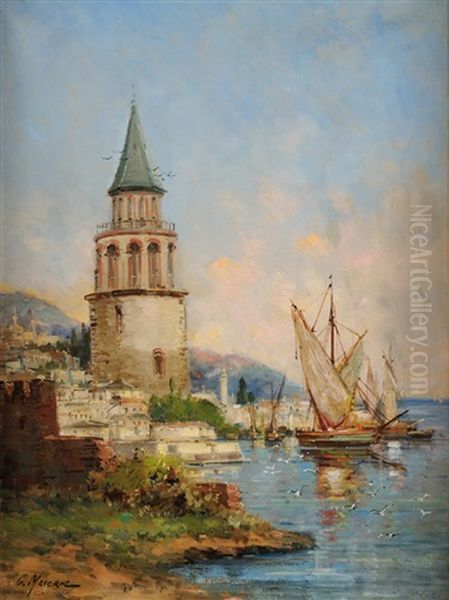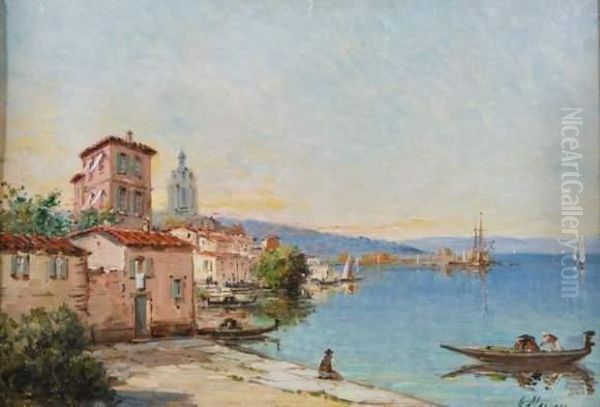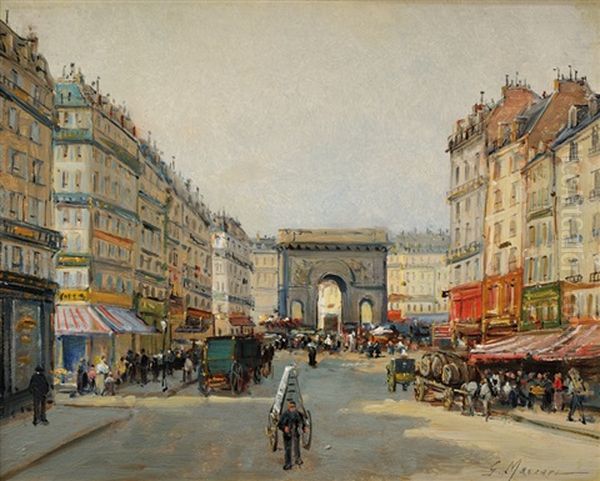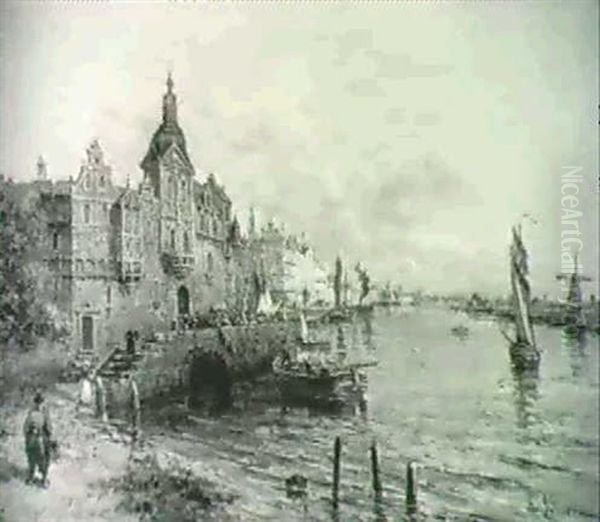Gustave Mascart, a French painter active during a vibrant period of European art history, dedicated his career to capturing the nuances of landscapes, both natural and urban. Born in 1834 and passing away in 1914, his life spanned an era of significant artistic transformation in France, witnessing the entrenchment of Realism, the revolutionary impact of Impressionism, and the diverse currents of Post-Impressionism. While perhaps not as globally renowned as some of his contemporaries, Mascart established a reputation for his detailed and evocative depictions of the world around him, particularly favouring scenes of waterways, ports, and city life.
His medium of choice was primarily oil on canvas, a traditional technique that allowed him to build up layers of colour and detail, effectively rendering the textures of stone, water, and foliage, as well as capturing the specific atmospheric conditions of the locations he painted. His works continue to appear in auction catalogues, suggesting a sustained interest among collectors and offering glimpses into the visual sensibilities of the late 19th and early 20th centuries.
The Artistic Milieu of 19th Century France
To understand Gustave Mascart's work, it's essential to consider the artistic environment in which he operated. The 19th century in France was a period of intense artistic debate and innovation. Landscape painting, once considered a lower genre, gained unprecedented prominence. The Barbizon School, active from the 1830s, championed painting directly from nature, focusing on realistic depictions of rural France. Artists like Jean-Baptiste-Camille Corot, Théodore Rousseau, and Jean-François Millet sought truthfulness in their portrayals of the countryside, influencing generations to come.

Following the Barbizon painters, Realism, spearheaded by Gustave Courbet, further emphasized objective representation of contemporary life, including its mundane aspects. Concurrently, the official Salon system, though often conservative, remained a crucial venue for artists to gain recognition. Towards the latter part of Mascart's active years, Impressionism emerged, radically challenging traditional techniques with its focus on light, colour, and fleeting moments, exemplified by artists such as Claude Monet and Camille Pissarro. Mascart's style appears to align more closely with the detailed, representational traditions preceding Impressionism, perhaps absorbing influences from Realism and the enduring legacy of the Barbizon School's dedication to landscape.
Mascart's Focus: Waterways, Ports, and Cityscapes
A recurring theme throughout Gustave Mascart's known oeuvre is his fascination with water and its adjoining environments. His paintings often depict scenes along rivers, coastal areas, and bustling ports. Titles such as Pêcheurs près de la rivière (Fishermen near the river) suggest tranquil, perhaps rural, riverside settings, capturing moments of everyday life integrated within the natural landscape. These works likely emphasized the calm reflection of light on water and the textures of the riverbanks.
His interest extended to more dynamic maritime environments. Works like Le Phare (The Lighthouse) point to coastal scenes, potentially focusing on the dramatic interplay between man-made structures and the natural forces of the sea and sky. Lighthouses were popular subjects, symbolizing guidance, resilience, and the boundary between land and sea. Mascart's treatment would likely have involved careful attention to the structure itself and the surrounding atmospheric effects.
Furthermore, Mascart painted views of specific ports, indicating an interest in scenes of commerce, travel, and maritime activity. Port de pêche en Italie (Fishing Port in Italy) and Vue d'un port italien (View of an Italian port) show that his artistic explorations were not confined to France. These Italian scenes would have offered different qualities of light, architecture, and boat designs compared to their French counterparts, providing fresh visual stimuli. The depiction of fishing ports often combined landscape elements with genre scenes, showing fishermen, boats, and harbour-side activities.

Urban landscapes also featured in his work. Quai de Seine à Paris (Quay on the Seine in Paris) places him directly within the tradition of Parisian city painting, a genre beloved by many artists before, during, and after his time. Such a painting would likely capture the unique atmosphere of the Seine, its bridges, barges, and the surrounding architecture, perhaps focusing on the effects of light on the water and stone embankments. Another title, Vue de la Porte Saint Martin, suggests a specific architectural landmark in Paris as his subject, showcasing his interest in the built environment alongside natural landscapes. His Vue de Montargis et de Bruxelles (View of Montargis and Brussels) further demonstrates his engagement with specific urban locations beyond Paris, capturing the character of these distinct cities.
Artistic Style and Technique
Gustave Mascart worked primarily in oils, employing a style characterized by careful rendering and attention to detail. While not exhibiting the loose brushwork or vibrant palette of the Impressionists, his approach was well-suited to capturing the specific topography and atmosphere of the locations he depicted. His landscapes and cityscapes are noted for their clarity and the skillful handling of light and shadow to create depth and realism.
His dedication to representing scenes accurately suggests an alignment with the broader Realist or Naturalist tendencies prevalent in the mid-to-late 19th century. This involved observing subjects closely and translating them onto canvas with a degree of fidelity. Whether painting the bustling quays of Paris, the tranquil waters of a river, or the picturesque harbours of Italy, Mascart aimed to convey a tangible sense of place. The signatures noted on his works, often simply "G. Mascart," confirm the authenticity of pieces that appear on the art market.
The consistency in his choice of subjects – landscapes often involving water – allowed him to develop expertise in rendering reflective surfaces, the movement of water, and the varied textures of natural and man-made elements within these scenes. His ability to capture the specific light conditions, whether the clear light of Italy or the softer light of Northern France, would have been a key component of his technique.
Representative Works
Several specific titles provide insight into Gustave Mascart's artistic output. Le Phare (The Lighthouse) likely depicted a coastal scene dominated by this important maritime structure, perhaps emphasizing its isolation or its role against a dramatic sky or sea. Such paintings often carry symbolic weight, representing guidance or steadfastness.
Port de pêche en Italie (Fishing Port in Italy) transports the viewer to the Mediterranean. One can imagine a scene filled with colourful fishing boats, perhaps nets drying in the sun, and the characteristic architecture of an Italian coastal town under a bright sky. Mascart would have focused on capturing the unique atmosphere and light of the location. Similarly, Vue de l'italie (View of Italy) suggests a broader landscape, perhaps a panoramic vista showcasing the Italian countryside or coastline.

Pêcheurs près de la rivière (Fishermen near the river) likely presented a more pastoral scene, focusing on the quiet activity of fishing within a French river landscape. These works often emphasized harmony between human activity and nature.
His urban scenes, like Quai de Seine à Paris and Vue de la Porte Saint Martin, would have offered detailed views of the French capital. The Seine painting might show barges, bridges, and riverside buildings, capturing the lifeblood of the city, while the Porte Saint Martin piece would focus on the architecture of this historic city gate. Vue de Montargis et de Bruxelles indicates his travels and his interest in capturing the essence of different urban environments.
Contemporaries and Artistic Context
Gustave Mascart worked during a period populated by numerous significant artists. While direct records of his interactions with specific painters are scarce according to the available information, his work exists within the context of their achievements and the prevailing artistic climate. His landscape focus resonates with the legacy of Jean-Baptiste-Camille Corot, whose poetic yet realistic landscapes profoundly influenced 19th-century art.
Auction records sometimes list Mascart's works alongside those of other artists active in the same period, painting a picture of the contemporary art market. Among these names are painters like Eugène Detaille, known for his precise military and historical scenes, suggesting a shared era rather than necessarily a shared style. Other contemporaries mentioned in such contexts include Emile Van Marck, recognized for his paintings of cattle and landscapes, often in the Barbizon tradition.
We also find mentions alongside Jean-Baptiste Alfred Breton (perhaps referring to the famous Jules Breton, known for his depictions of peasant life and rural scenes) and Eugène Lévy, who painted historical and allegorical subjects. Landscape and genre painters like Pierre-Eugène Montanet also belong to this broad artistic generation. Less universally famous names appearing in similar auction contexts include Jean Eugène Mathon, Louis Remy Mathieu, Albert Reiss, Calvi, and Krivout. While the appearance in catalogues doesn't confirm personal relationships, it places Mascart within a diverse group of artists whose works were being collected and sold during the late 19th and early 20th centuries. Mascart's dedication to landscape and cityscape painting provided a distinct contribution within this varied artistic field.
Market Presence and Legacy

The frequent appearance of Gustave Mascart's paintings in auction results and catalogues over the years indicates a consistent market presence. Works like Pêcheurs près de la rivière, Vue de l'italie, Le Phare, and Port de pêche en Italie are regularly documented in sale listings. This suggests that his work found favour with collectors during his lifetime and has continued to be appreciated and traded subsequently.
While he may not have been associated with the major avant-garde movements that dramatically reshaped art history, Mascart contributed to the rich tapestry of French landscape painting in the 19th century. His focus on specific locations, rendered with detail and atmospheric sensitivity, provides valuable visual records of France and parts of Italy and Belgium during his time. His paintings offer accessible and often picturesque views, appealing to a taste for well-executed, representational art.
His legacy lies in these carefully observed scenes. He was a chronicler of place, capturing the character of Parisian quays, provincial rivers, coastal towns, and foreign ports. For collectors and enthusiasts of traditional 19th-century European landscape painting, Mascart's work remains relevant and visually engaging. The lack of extensive biographical information or records linking him to specific artist groups or major exhibitions means his reputation rests primarily on the paintings themselves.
Distinguishing the Artist from the Scientist
It is important to note a potential point of confusion regarding the name Mascart in 19th-century France. Gustave Mascart, the painter (1834-1914), should not be confused with Éleuthère Mascart (1837-1908), a prominent French physicist known for his work in optics, electricity, and meteorology. Some sources might inadvertently mix details between the two figures. The painter Gustave Mascart's contributions were firmly within the realm of the visual arts, specifically landscape painting, and are distinct from the scientific achievements of his near-contemporary, the physicist Éleuthère Mascart.
Conclusion
Gustave Mascart remains a figure primarily known through his artistic output: the numerous landscape and cityscape paintings that continue to circulate on the art market. As a French painter active from the mid-19th to the early 20th century, he worked within established traditions of representational art, focusing on detailed and atmospheric depictions of specific locations. His preference for scenes involving water – rivers, ports, coastlines – is evident from the titles of his works, which span locations in France, Italy, and Belgium.
Though perhaps overshadowed by the revolutionary artists of Impressionism and Post-Impressionism, Mascart carved out a niche for himself, creating appealing and skillfully executed paintings that captured the visual character of his era. His work offers a window onto the landscapes and urban environments of late 19th and early 20th century Europe, rendered with a careful hand and an eye for detail and atmosphere. He stands as a competent and dedicated practitioner of landscape art within the rich artistic context of his time.